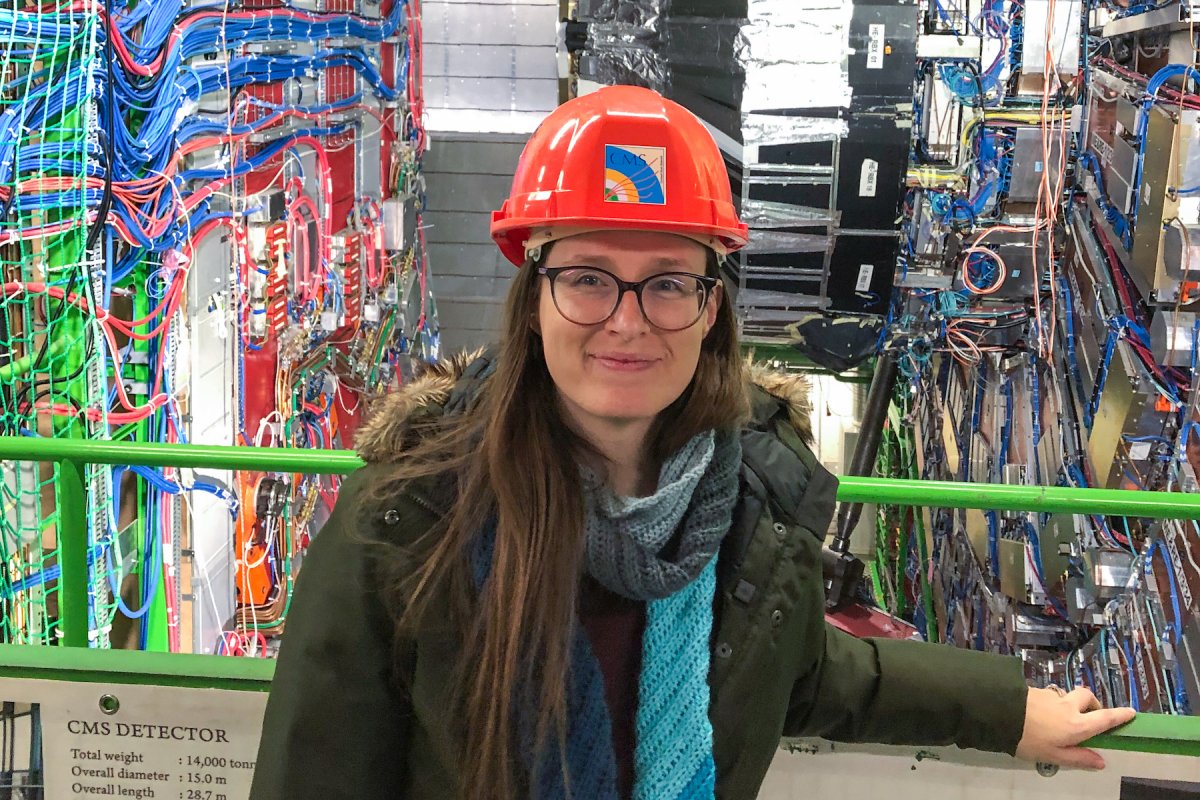Armed with data from the world’s largest particle accelerator, CSE physics professor is on a mission to discover

U of M Assistant Professor Nadja Strobbe studies what happens when you ‘smash’ tiny particles together
Located just outside of Geneva, Switzerland, about 100 meters underneath the ground, the Large Hadron Collider (LHC) spews beams of particles through a 17-mile long circular tube at an unfathomable speed—nearly three hundred million meters per second, or 99.9999991% of the speed of light. University of Minnesota College of Science and Engineering (CSE) Assistant Professor Nadja Strobbe, along with thousands of scientists from around the world, is using this machine to better understand the world as we know it.
At certain points along the tube, magnets cause the beams of particles to collide. At these points, “experiments,” or particle detectors, are set up to detect the spray of other types of particles that are created in the collisions. Researchers use this collision data both to study current physics and to discover new phenomena.
“We’re trying to learn more about the fundamental building blocks of the Universe,” said Strobbe, who’s a faculty member in the CSE School of Physics and Astronomy on the Twin Cities campus. “What are all the forces of nature? How do they interact with each other? Why do particles have certain masses? Why is the Universe made out of matter and not antimatter?”
“We try to understand how it all works at a fundamental level,” she said, “and it turns out the best way to do that is by smashing things together and seeing what comes out.”
While high-energy physics can seem abstract to some, Strobbe says there are a lot of tangible benefits to society.
“If you think back to more than a hundred years ago when the electron was first discovered, we thought electricity was this funny thing you could show as a party trick, but look at how we’re using it now,” she said. “There are also a lot of research impacts in medicine. CT scans, MRIs, and radiation treatments are often powered by some sort of mini, internal particle accelerator or powerful magnet within the machine.”
The LHC is housed within CERN, the European Organization for Nuclear Research, which is one of the largest and most respected research centers in the world. It’s the most powerful particle accelerator of its kind and can even reproduce the energy of all but the most energetic cosmic rays in outer space—all under safe, controlled laboratory conditions, of course.
Strobbe’s main projects involve data from the Compact Muon Solenoid (CMS) experiment within the collider, and her work spans everything from machine learning to the discovery of never-before-seen particles.
By tracing the “sprays” from these collisions through their detector in the LHC, Strobbe and her team can determine the properties of the resulting particles—and be on the lookout for any new ones.
Currently, she and her team are on the hunt for a new type of particle: the “top squark.” This particle is closely related to quarks, which physicists believe to be the fundamental makeup of matter in the Universe. Theoretically, these top squarks could exist, but no one has found hard evidence of them yet.
Aside from helping us better understand the world around us, Strobbe’s work also intersects with some of today’s big tech topics—like artificial intelligence.
The detector Strobbe’s team uses tracks about 40 million particle collisions every second, which results in mass amounts of data that can be difficult for humans to parse through. Her lab recently got a $232,000 grant from the United States Department of Energy (DOE) to improve the accuracy of machine learning techniques for interpreting this data.
Strobbe leads one of three University of Minnesota physics teams studying data from the LHC. She joined the U in 2019 because of the strong community and sense of collaboration in the School of Physics and Astronomy.
The University also has a reputation in the physics field for involving undergraduate students in big research projects. It’s perfect for Strobbe, whose favorite part about being a professor is combining research with teaching students.
“Having that direct interaction with students has been very fulfilling for me,” she said.
“It's always amazing to me how they start off knowing basically nothing about particle physics. But then, after just a few months, they’re making meaningful contributions, and they take that experience with them wherever they go next.”
Story by Olivia Hultgren
